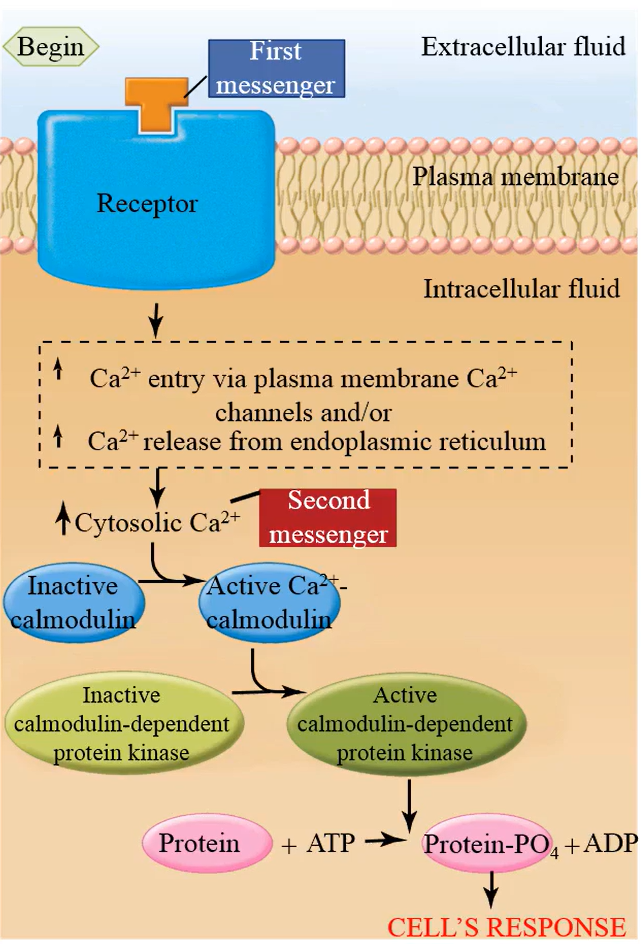Cell Physiology Lecture 3
1/74
There's no tags or description
Looks like no tags are added yet.
Name | Mastery | Learn | Test | Matching | Spaced |
|---|
No study sessions yet.
75 Terms
What are chemical messengers?
A form of intercellular communication (b/w cells)
Chemical messengers may be lipid _____ or _____.
Soluble, insoluble
Chemical messengers is used for the process of:
signal transduction
What is signal transduction?
the sequence of events between the binding of a messenger to a receptor and the production of a cellular response
Receptors have specific:
binding sites for a specific messenger
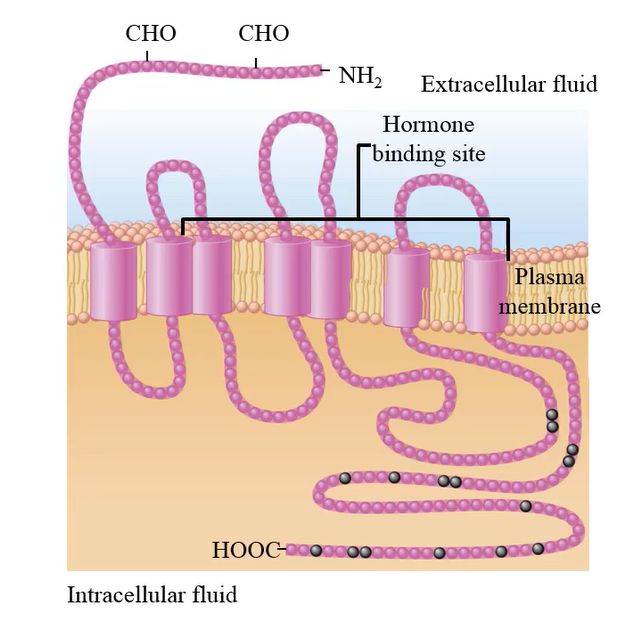
Receptors show _______, in that they have:
Saturation: a defined number of binding sites for a messenger (a single receptor may have only 1 or 2 binding sites for a messenger)

Receptors bind different messengers with different:
Affinities
What is affinity?
refers to how strong a receptor and messenger bind; high affinity = they bind very strongly, requiring low concentrations of messenger. Low affinity = interaction between messenger and receptor is weaker and it requires higher concentrations of a messenger to bind
Some receptors bind a particular substance with:
high affinity while other receptors bind to their substance with low affinity.
Receptors may be found on the:
plasma membrane or intracellularly, in the cytosol or in the nucleus
Intracellular receptors are found:
inside the cell, in the cytoplasm or in the nucleus
Lipid-soluble chemical messengers diffuse:
across the plasma membrane and bind to intracellular receptors
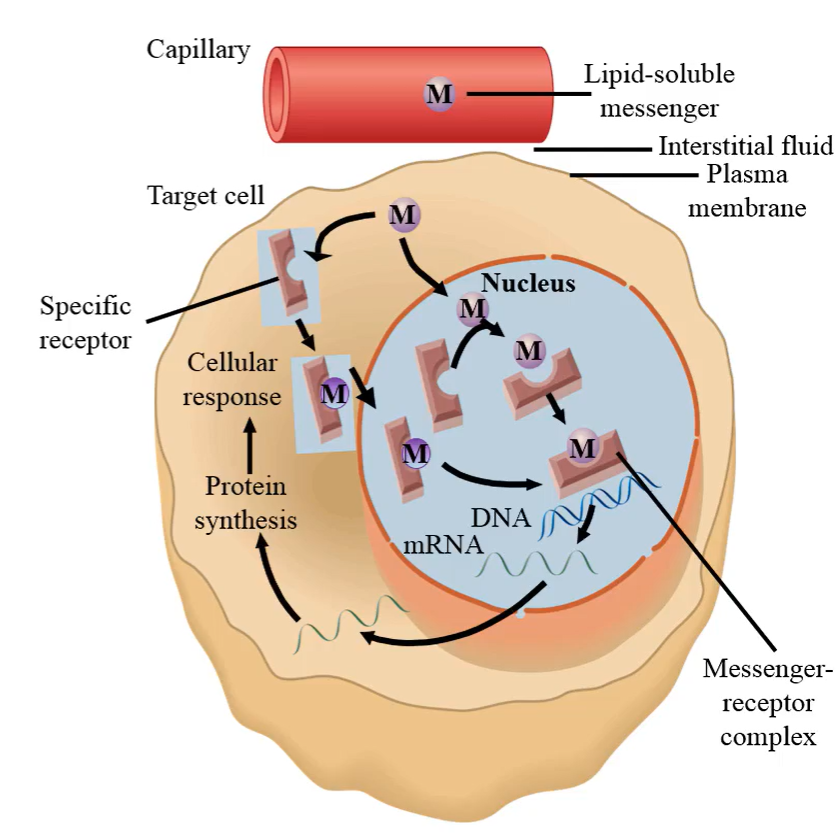
Steroid and thyroid hormones are examples of:
intracellular receptors
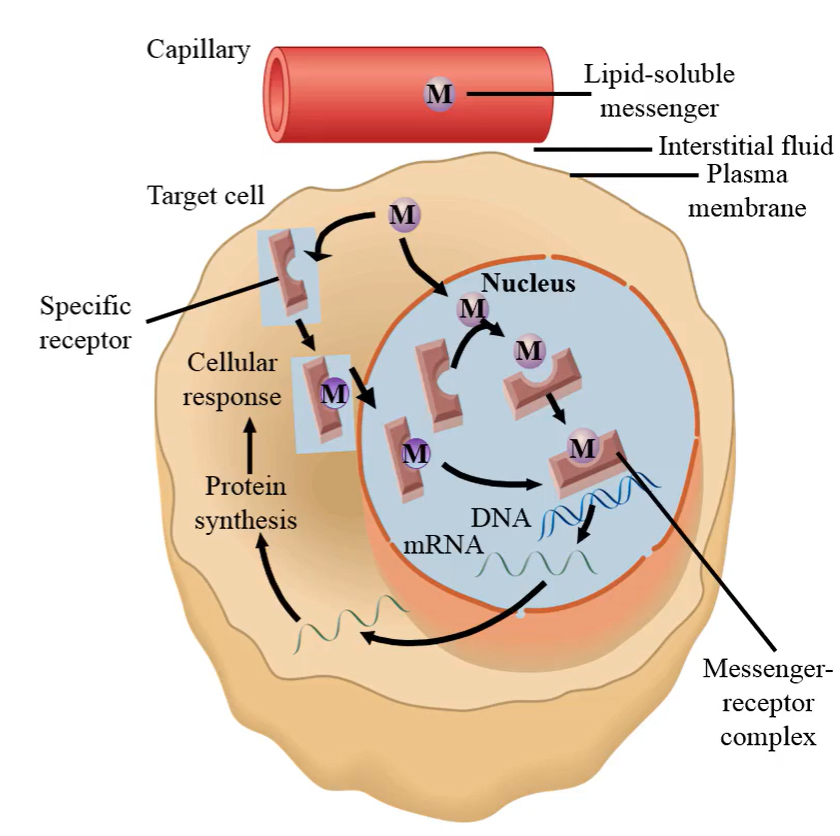
Chemical messengers which bind to intracellular receptors act as:
transcription factors
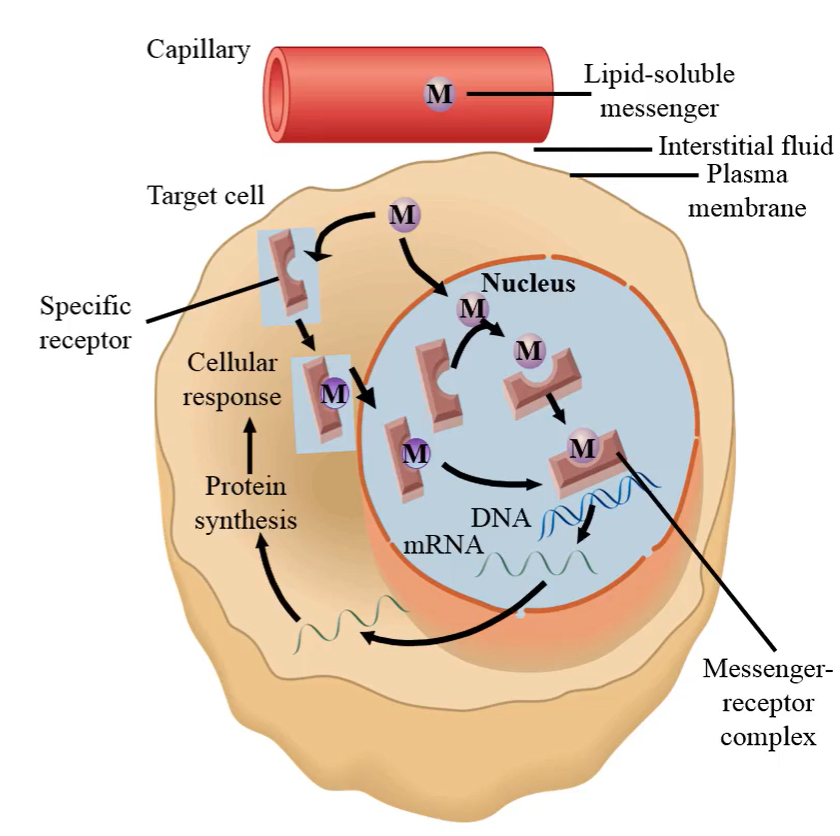
What do transcription factors do in intracellular receptors + chemical messengers?
They alter the rate of transcription of mRNA in the nucleus by binding to a response element
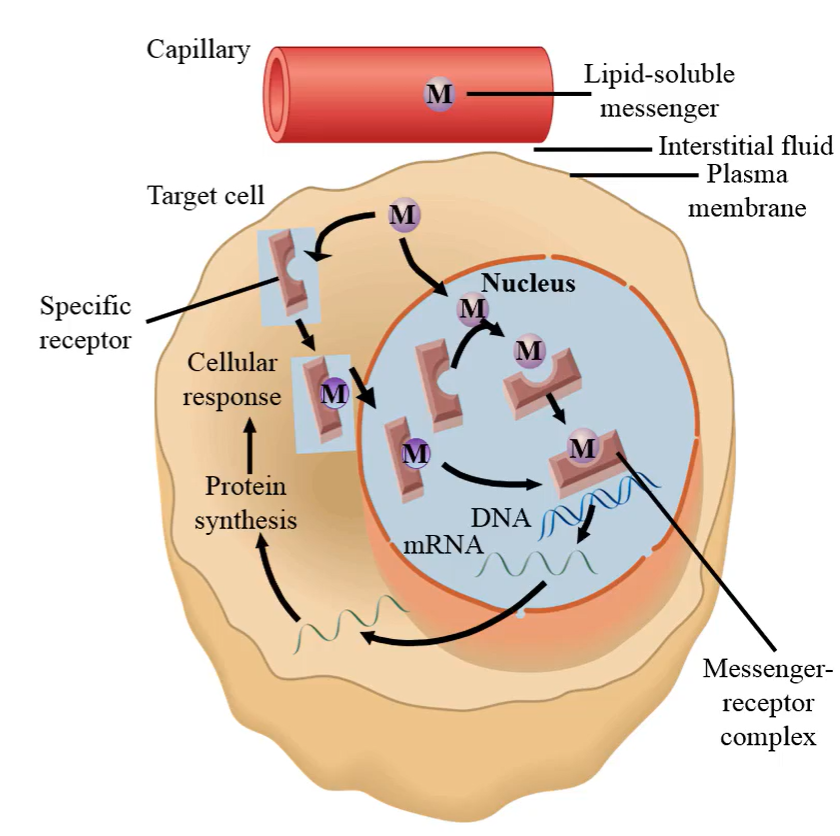
A response element is a:
specific sequence of DNA near the beginning of a gene
By binding to the response element, a chemical messenger can alter the rate of:
transcription of a gene, which will alter the rate of translation of the mRNA into a protein (each gene contains the instructions for producing a specific protein)
Transcription factors alter the rate of:
protein synthesis
Membrane-bound receptors are:
Chemical messengers that are water-soluble (hydrophilic; lipid-insoluble), binds to receptors on the extracellular surface of the plasma membrane
Peptide or protein hormones are what kind of receptors?
Membrane-bound
3 types of membrane-bound receptors are:
channel-, enzyme-, or G-protein linked.
The extracellular chemical messenger that binds to a specific membrane-bound receptor is a:
First messenger
a substance that enters or is generated in the cytoplasm of a cell following the binding of the first messenger to its receptor is a:
Second messenger
an enzyme that phosphorylates another protein, or adds phosphate groups to the protein is called:
Protein kinase
By adding phosphate groups to a protein, a protein kinase alters:
the activity of another protein
Receptors that are ligand-gated ion channels, and function as enzymes, are what type of receptors?
Membrane bound
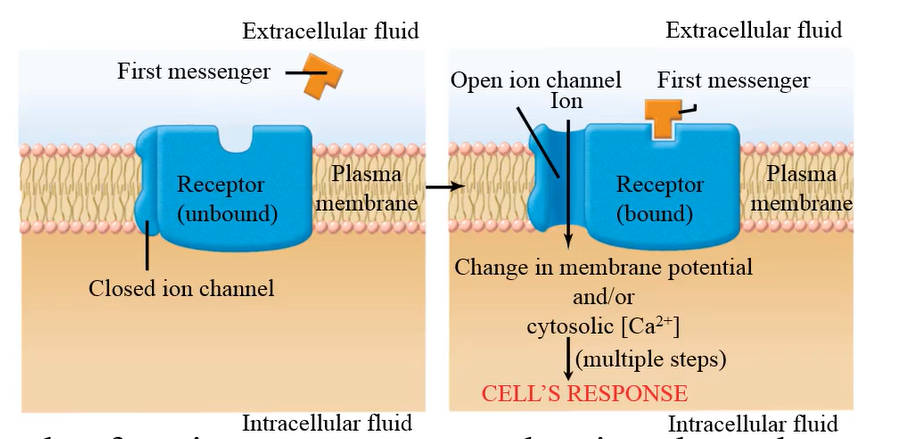
What receptor (a protein) has a receptor component with binding sites for a chemical messenger and an ion channel component. It is one protein that functions both as a receptor and an ion channel?
Receptors that are ligand-gated Ion channels
What are the steps of signal transduction for receptors that are ligand-gated ion channels?
A first messenger binds to binding sites on the receptor. An ion channel in the receptor protein opens. Ions move through the channel. As the ions have a charge, they alter the electrical properties of the cell and produce a response.
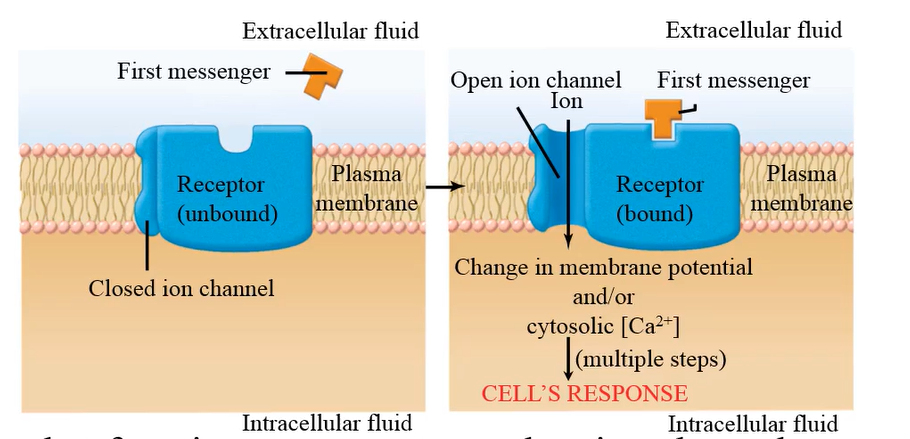
The process of signal transduction in receptors that are ligand-gated ion channels is a:
Fast process as the receptor and ion channel are a single (same) protein
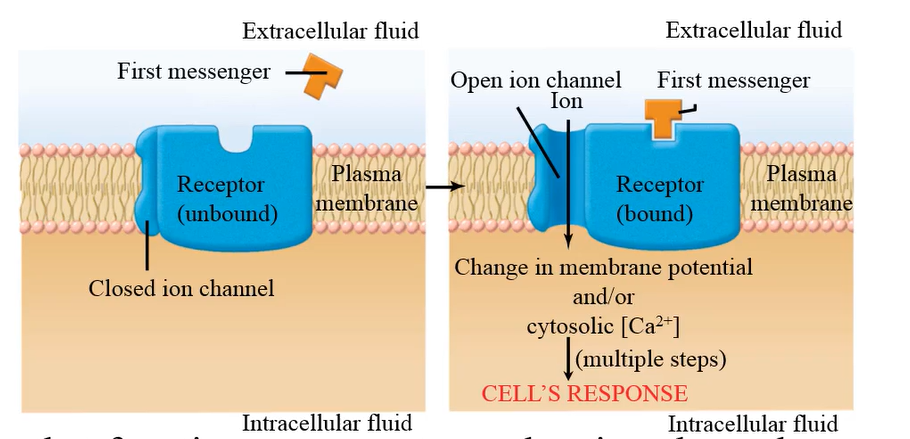
What kind of receptor has a receptor component with binding sites for a chemical messenger and intrinsic enzyme activity (intrinsic = within the receptor protein)?
Receptors that function as enzymes
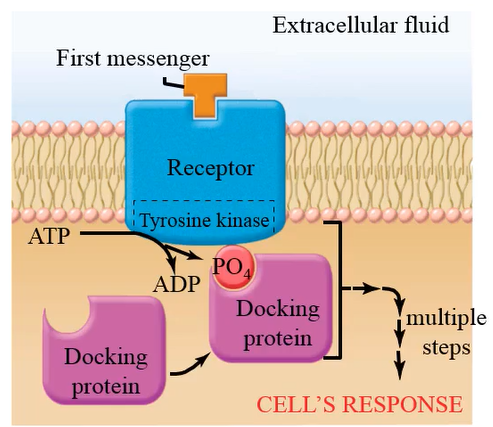
A receptor that functions as enzymes is also called:
receptor tyrosine kinases; the enzyme part of the receptor is a kinase that phosphorylates (adds phosphates to) tyrosine amino acid residues
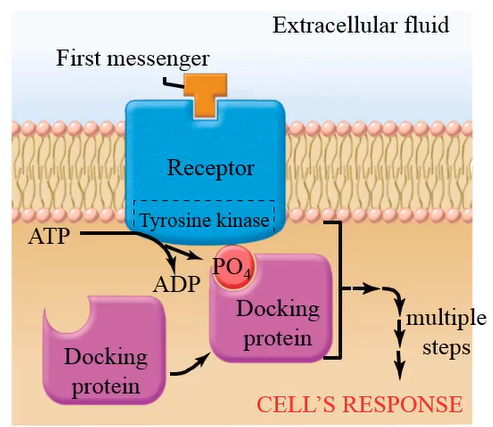
The tyrosine kinase part of a receptor that function as enzymes does what?
autophosphorylates or self phosphorylates tyrosine amino acid residues on the receptor
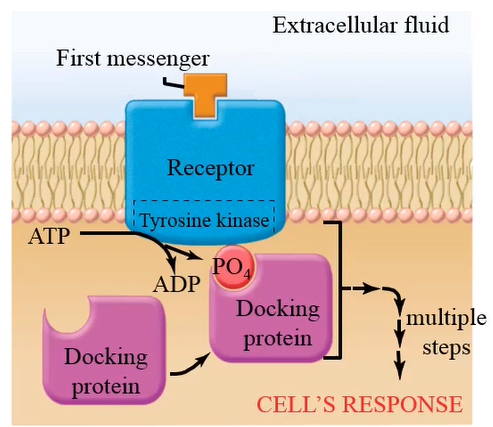
The phosphorylated tyrosines (phosphotyrosines) on receptors that functions as enzymes act as:
Docking sites for proteins in the cytoplasm of the cell
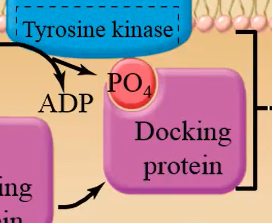
Once a protein binds to the phosphotyrosines in receptors that functions as enzymes, the protein is:
activated by phosphorylation, and will bind to other proteins in the cell to eventually produce a response
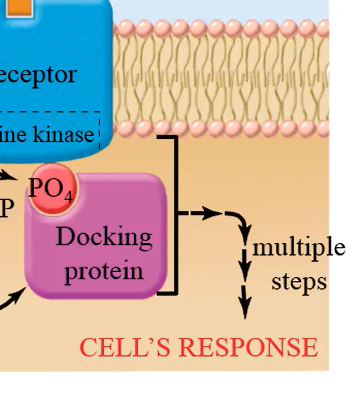
G-protein receptors are what kind of receptors?
Membrane bound
Membrane-bound receptor that binds extracellular chemical messengers are called:
G-protein linked receptor
G-proteins are found at the:
cytosolic (within cytosol) surface of the plasma membrane
G-proteins bind:
guanosine nucleotides (GDP or GTP), and this is why they are called G proteins (G= guanosine)
A G-protein is made of ___ subunits
3; called alpha, beta and gamma
G-proteins function as a link between:
the receptor in the plasma membrane and an effector (target) protein, which is an ion channel or an enzyme
Both the receptor and the effector protein interact with the:
G-protein
Only the ____ subunit of the G-protein binds to GTP or GDP, not the beta and gamma subunit
Alpha
In G-protein linked receptors, alpha unit of the G-protein binds:
the guanosine nucleotides GDP and GTP
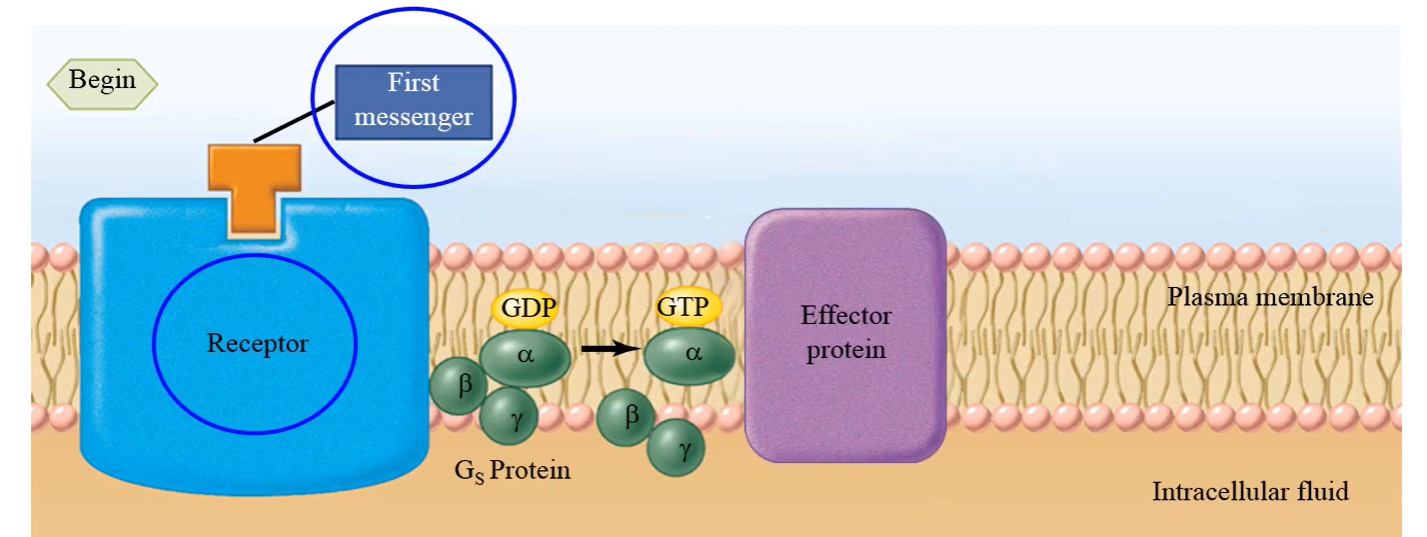
When alpha subunit of G-protein is inactive, it binds to:
GDP
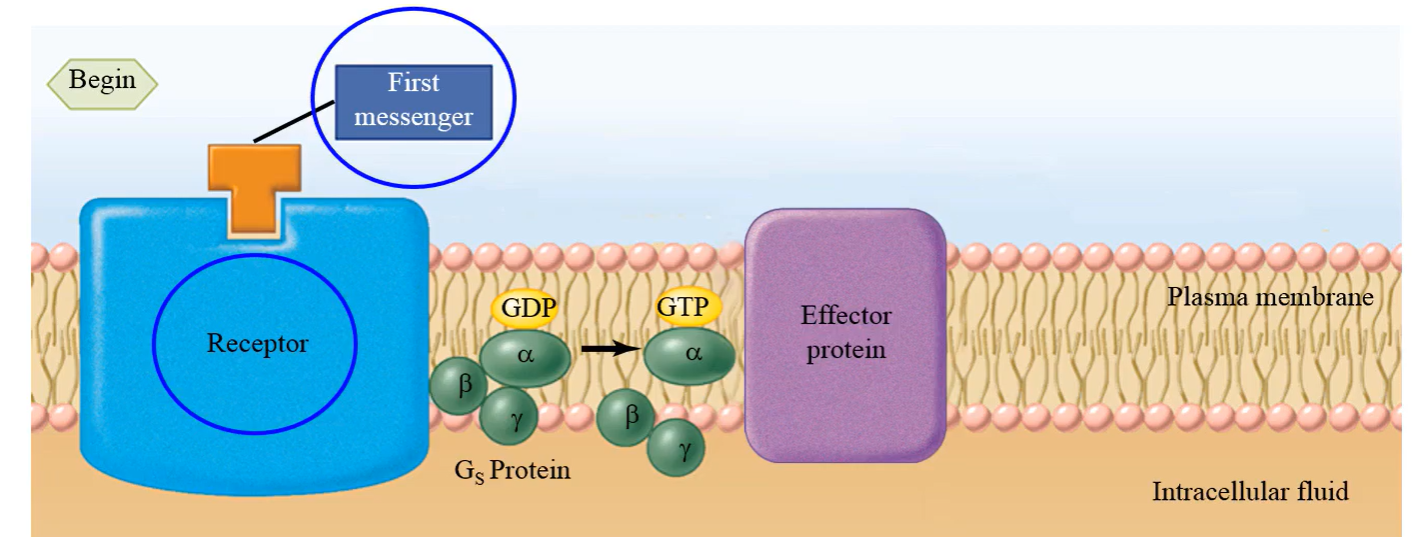
When alpha subunit is active it binds to:
GTP
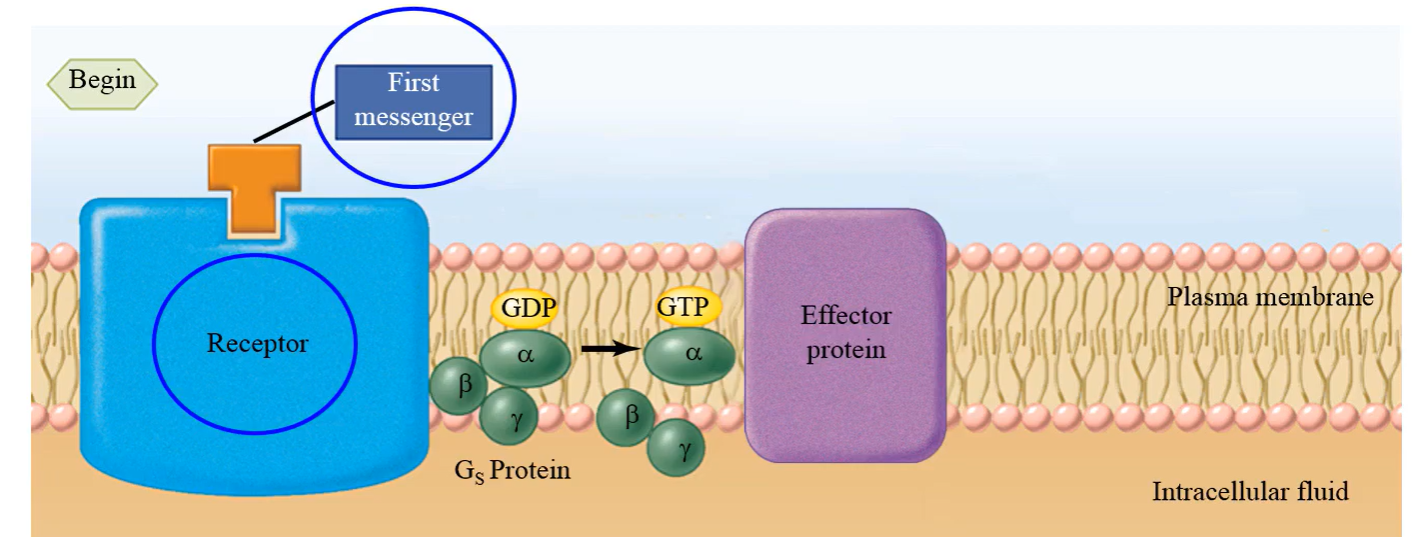
Binding of an extracellular first messenger to a membrane-bound receptor of a G-protein linked receptor causes a:
conformational change in that receptor, altering the affinity of the alpha subunit of the G-protein for GDP
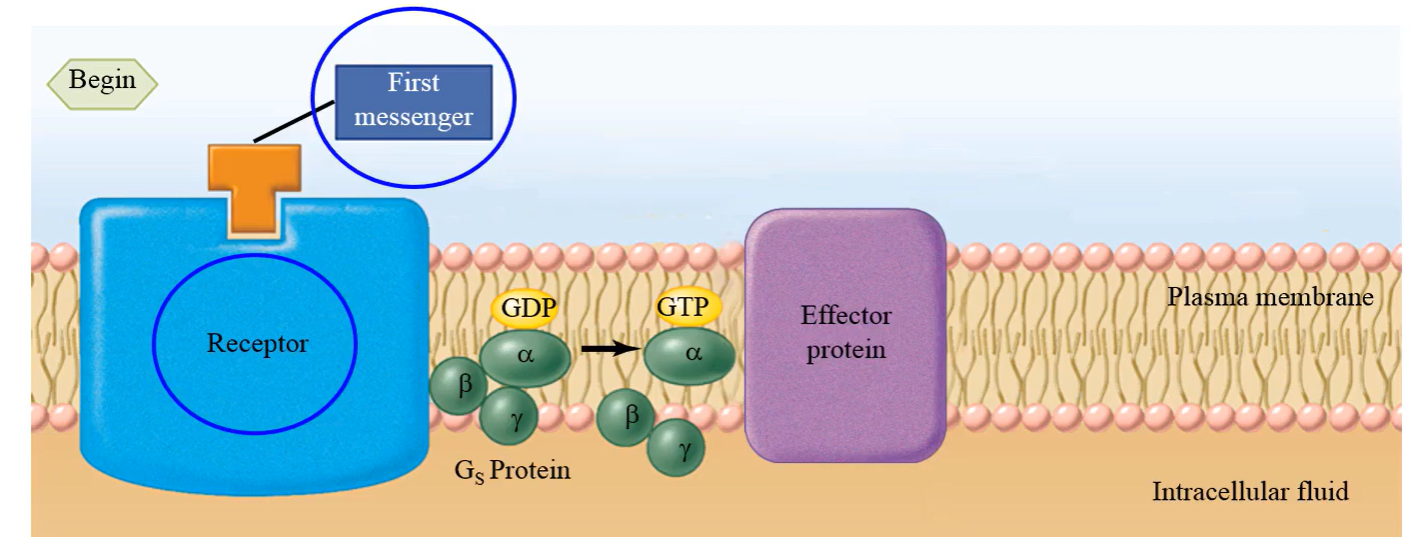
After binding of an extracellular first messenger, the affinity of the alpha subunit for GDP:
decreases and the affinity for GTP increases; the alpha subunit releases GDP and binds GTP
After binding of an extracellular first messenger, and release of GDP for GTP, the G protein will now:
dissociate from the receptor and the GTP-bound alpha subunit is activated and separates from the beta and gamma subunits
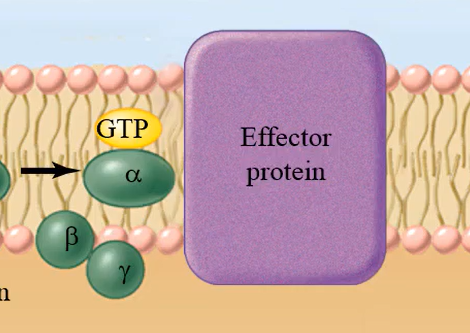
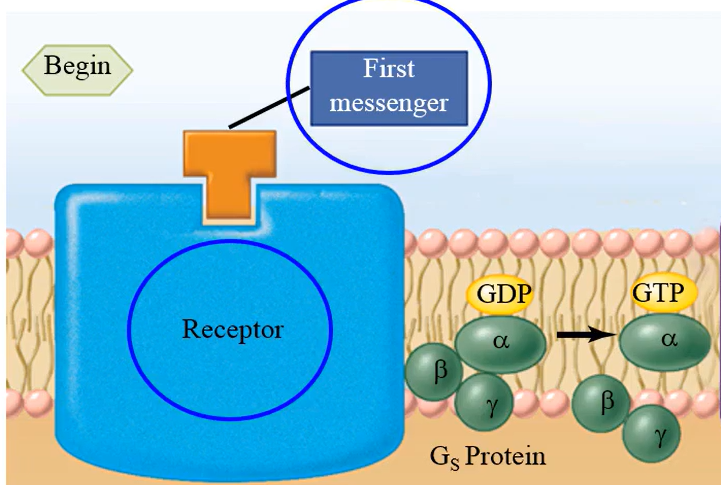
After the binding of extracellular first messenger, release of GDP and binding of GTP, dissociation from receptor, activated alpha subunit moves to its:
target protein in the membrane, called the effector protein

The GTP-bound alpha subunit will do what to the activity of the effector protein?
Alter it, to produce a response in the cell
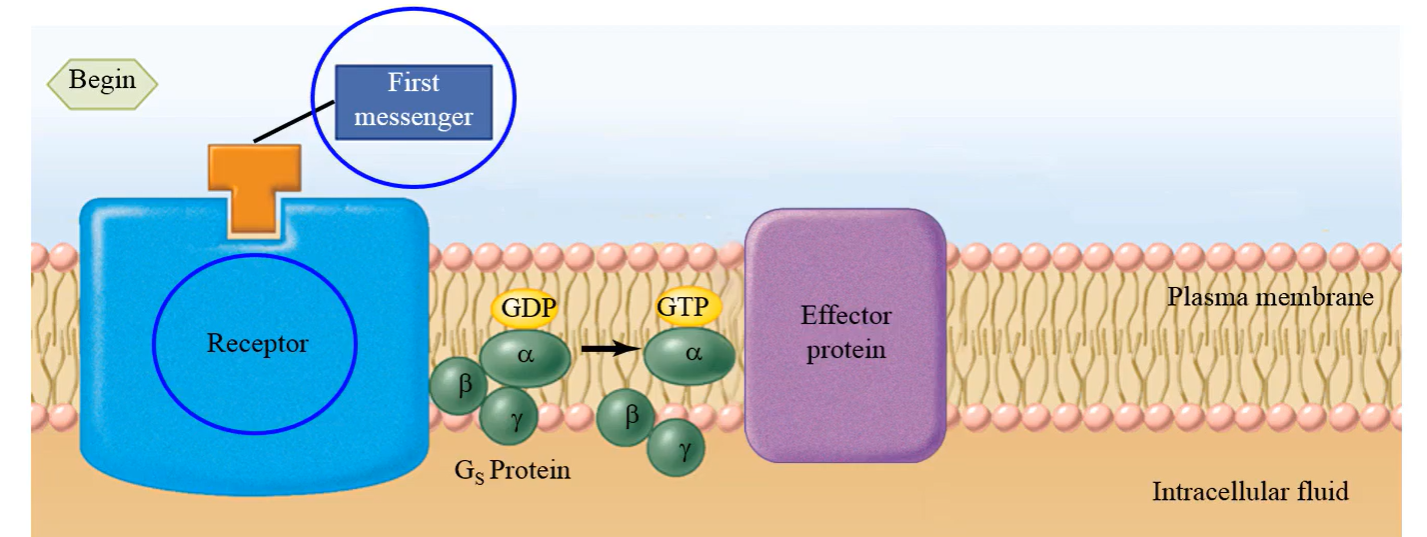
After GDP → GTP, via G-protein linked receptors, and the altered activity of effector protein to produce a response in the cell, what happens next?
Activated alpha subunit hydrolyzes/breaks down the GTP to GDP and inorganic phosphate, returning to the inactive state bound to GDP. The alpha subunit recombines with the beta and gamma units, anchoring the alpha in the membrane. All G-protein subunits recombines w/ receptor.
How does binding of a first messenger alter the activity of an effector ion channel?
1. Binding of first messenger to receptor causes conformational change in receptor. 2. Affinity of α-subunit for GTP increases; GDP dissociates, GTP binds. 3. GTP-bound α-subunit dissociates from β and γ; moves to ion channel. 4. Ion channel opens or closes (depending on state of channel prior to binding of GTP-bound α-subunit), alters flow of ions across membrane

What is a Gs protein?
It stimulates or activates an enzyme
What is a Gi protein?
It inhibits an enzyme
How does binding of a first messenger alter the activity of an effector enzyme?
1. Binding of first messenger to receptor causes conformational change in receptor. 2. Affinity of α-subunit for GTP increases; GDP dissociates, GTP bind. 3. GTP-bound α-subunit dissociates from β and γ; moves to enzyme. 4. There are different types of G-proteins: If the G-protein is a Gs protein, it stimulates or activates the enzyme (S= stimulatory); if the G-protein is a Gi protein, it inhibits the enzyme (I= inhibitory). 5. Altering the activity of the enzyme alters the production of a second messenger by the enzyme in the cytosol
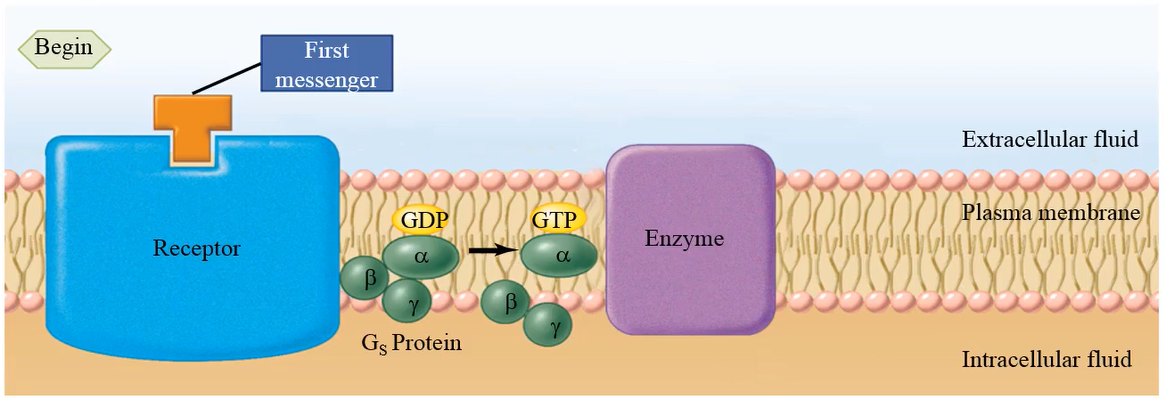
What is the most common second messenger system found in the cells in our body?
cAMP second messenger system
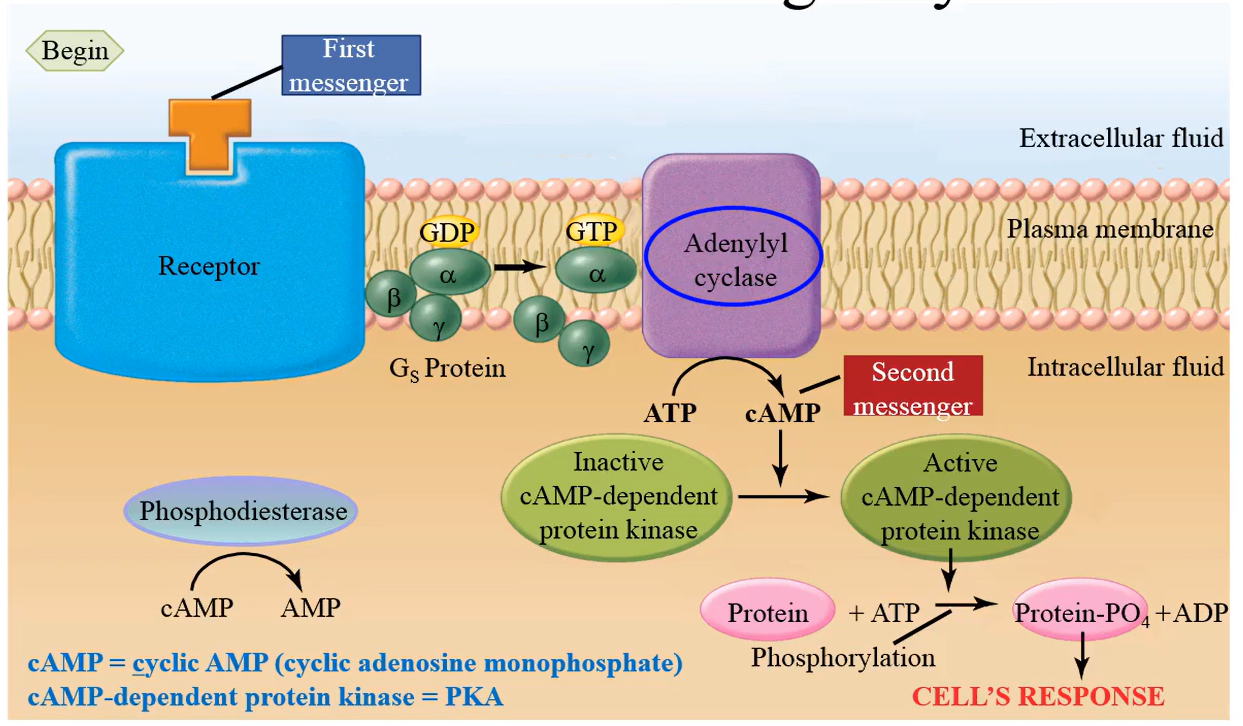
cAMP is what kind of messenger?
second (in cytosol)
Adenylyl cyclase is a:
membrane-bound enzyme
protein kinase A (PKA) requires what to activate it?
cAMP
What are the steps to produce cAMP?
Binding of first messenger to receptor causes confirmational change in receptor, increasing affinity of alpha subunit GTP. GTP binds after GDP release.
Activated alpha subunit of Gs separates from beta and gamma subunits & moves and binds to adenylyl cyclase, activating it.
adenylyl cyclase catalyzes the conversion of cytosolic ATP molecules into cyclic AMP at cytoplasmic surface of plasma membrane
Cyclic AMP acts as second messenger and diffuses through cytoplasm
cAMP binds to and activates protein kinase A (PKA), also called cyclic AMP-dependent protein kinase.
Activated PKA catalyzes the phosphorylation of proteins in the cell by transferring a phosphate group from ATP to cellular proteins
Once these cellular proteins have been phosphorylated, their activity is altered, resulting in a cellular response
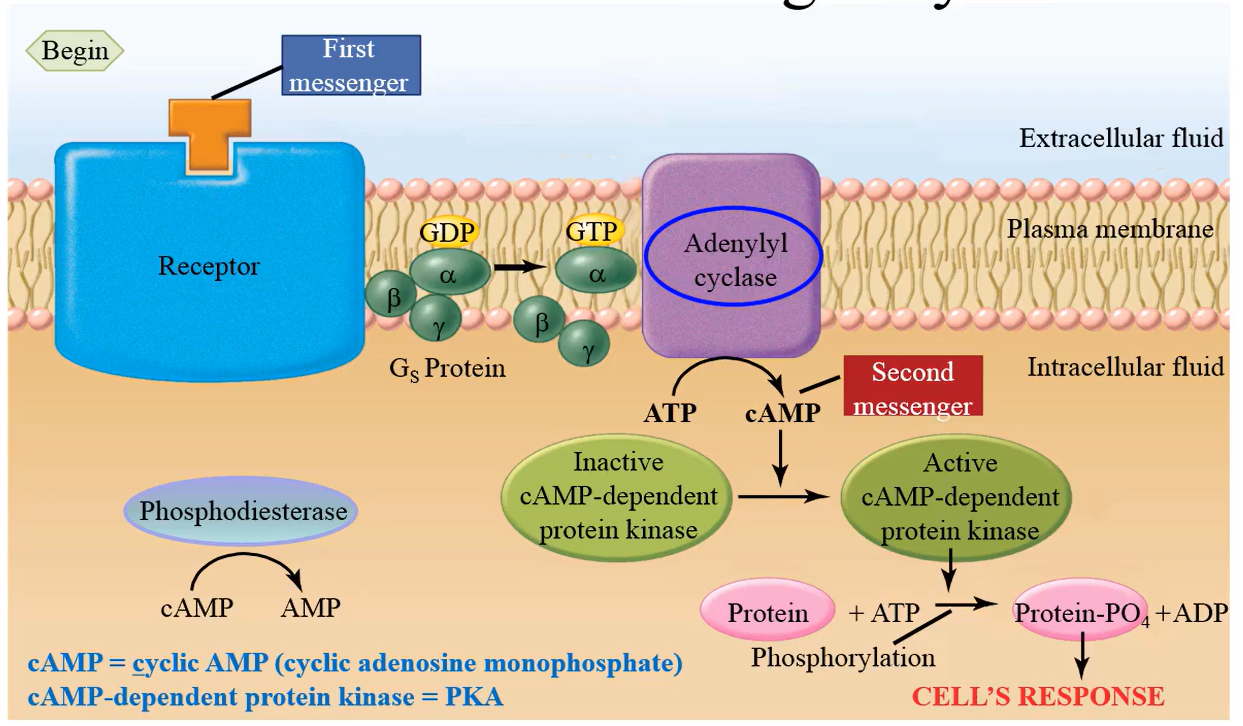
What part of the G protein is associated with a G-protein linked receptor?
Beta and gamma subunit
Calcium may act as a:
second messenger in cells
Calcium is normally found in low concentrations in the:
Cytoplasm
Calcium may enter the cell from the:
extracellular fluid following the binding of a first messenger to a receptor
When calcium acts as a second messenger, the receptor may be a receptor that is a:
ligand-gated ion channel, or G-protein linked receptor, both allows calcium to enter the cell and its concentration increases in the cytoplasm.
What occurs when calcium acts as a second messenger with a ligand-gated ion channel?
the intrinsic ion channel opens and allows calcium to move into the cell
When calcium acts as a second messenger with a G-protein linked receptor, calcium channel in the membrane does what?
opens following GTP binding to channel.
the ER may store:
calcium; it has a high concentration of calcium
The increase in calcium levels in the cytoplasm is not enough to produce:
a response in the cell; calcium that has entered the cytoplasm from the ECF will bind to receptors on an organelle called endoplasmic reticulum
Binding of calcium to receptors on the ER causes:
calcium to be released from the ER, further increasing levels in the cell
calcium entering the cell from the ECF causes its own release from the ER into the cytoplasm, a phenomenon called:
calcium induced calcium release
When calcium induced calcium release occurs, calcium now acts as a:
Second messenger
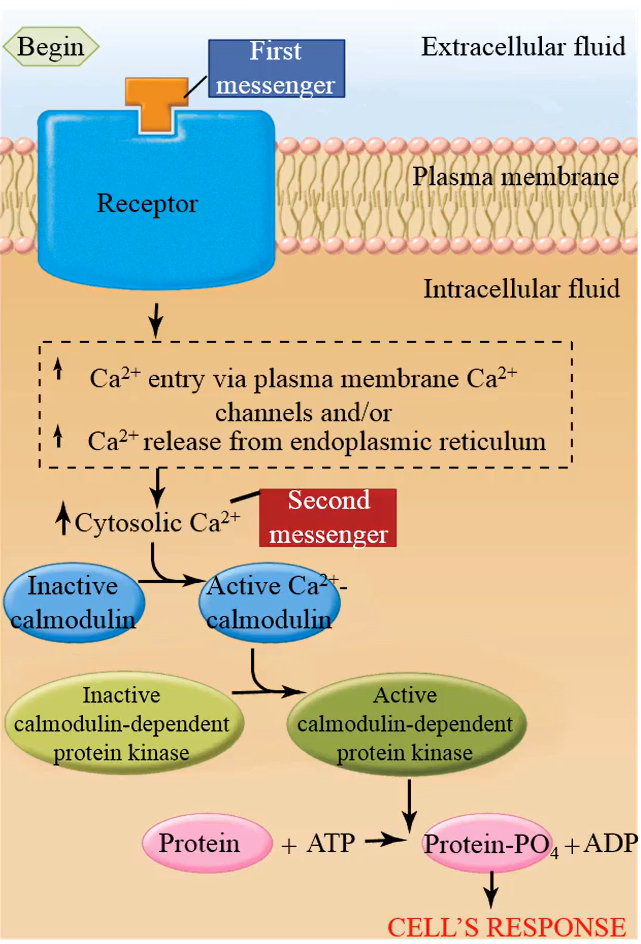
Calcium activates:
calmodulin, a cytosolic protein that is normally found inactive in the cell; calmodulin requires calcium to activate it
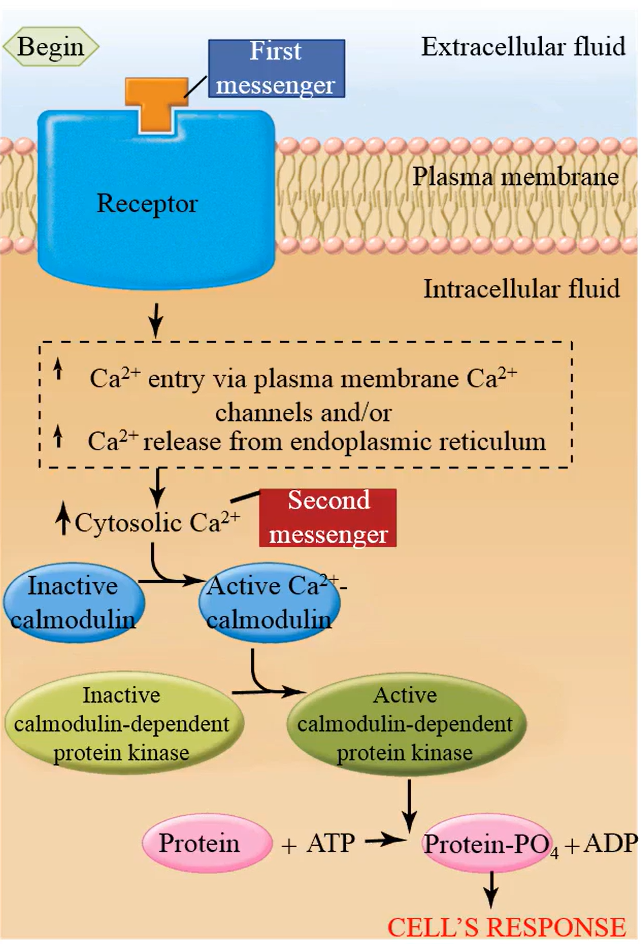
Active calmodulin activates what when calcium acts as a second messenger?
calmodulin-dependent protein kinase
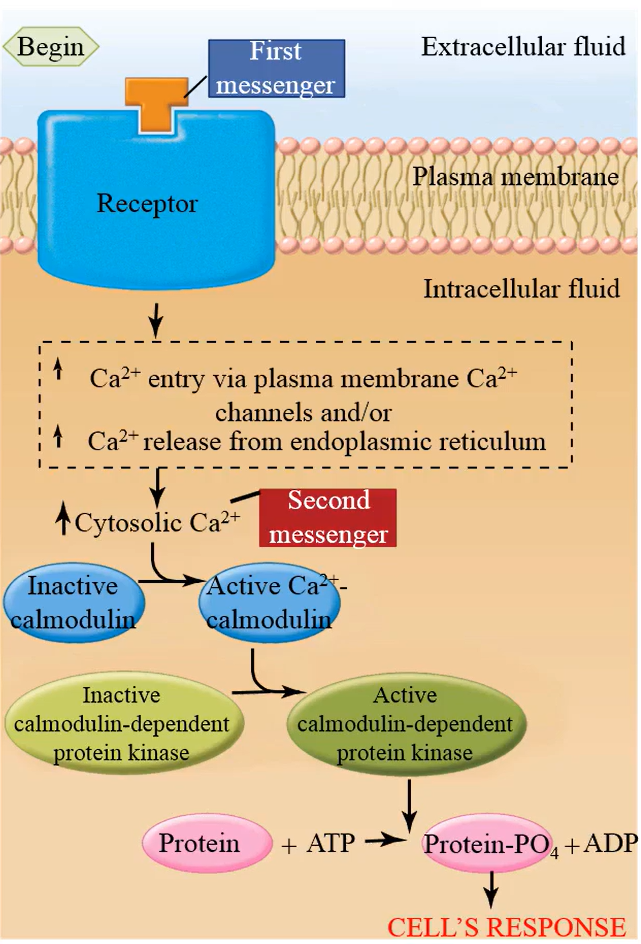
The protein kinase does what in the cell when calcium acts as a messenger?
It phosphorylates proteins in the cell, producing a response.
